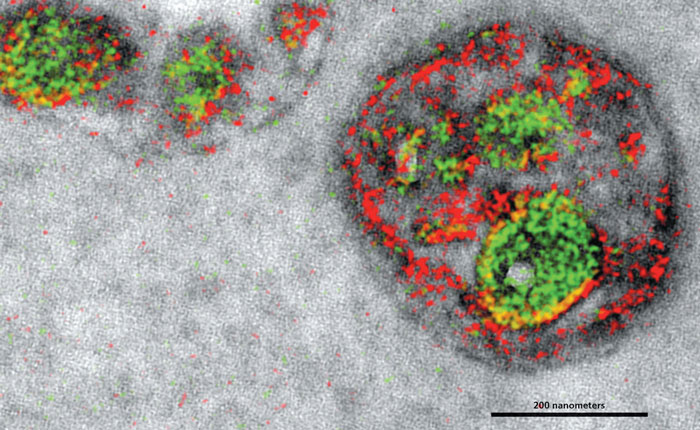Seeing Biology's Tiniest in Color
By Robert Frederick
How do you see the color of objects that are smaller than the smallest wavelength of visible light?
January 18, 2017
From The Staff Biology Technology Microbiology
How do you see the color of objects that are smaller than the smallest wavelength of visible light?
What does color even mean for objects so small?

Stephen R. Adams et al.
We see color because when light strikes an object some of the visible spectrum is reflected back to our eyes. The wavelengths of those colors of the rainbow start around 390 nanometers (violet) and go to about 700 nanometers (red). But when objects are smaller than the smallest wavelength of light, we have to use beams of electrons—instead of light—to illuminate them.
In the electron microscopes with the best magnification, the resulting image is made—pixel by pixel—from a single brightness value, which is based on how many electrons make it through the object. That single brightness value only allowed for grayscale images, until now.
It took 13 years for Stephen Adams and his team at the University of California, San Diego, to figure out how to do it. The solution they came up with involved tagging specific proteins and peptides (biological compounds that, like proteins, are also made from amino acids, but are smaller than proteins) each with a different metal. Different metals provide distinctive signals to the electron microscope, allowing the researchers to falsely colorize the locations of the proteins and peptides.
This image (above) shows the locations of a specific protein (green) and peptide (red) inside an endosome (a compartment attached to a cell’s membrane that helps sort incoming substances—the endosome itself is about 400 nanometers across). Before this image was made, no one had ever seen so clearly an endosome's internal structure.
I spoke with Adams about the proof-of-principle imaging technique and wrote about it in a Sightings column for the January–February issue of American Scientist. But I always enjoy hearing directly from the researcher too, don’t you?
American Scientist Comments and Discussion
To discuss our articles or comment on them, please share them and tag American Scientist on social media platforms. Here are links to our profiles on Twitter, Facebook, and LinkedIn.
If we re-share your post, we will moderate comments/discussion following our comments policy.